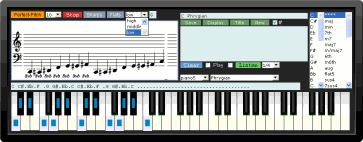Note: You can use the keyboard (you type on) as a virtual piano.
Just click "Play" to hear the playback.
A link should also appear in the upper left text input area.
You can send click (copy/paste) that and send your tune anywhere.
Spacebar equals rest, plus sign combines, clear start over
Like this...
Moonlight Sonata
You can also type your name in the doodle box and click play to hear it.
This program has complete sound. You will need plug-ins allowed to hear it



